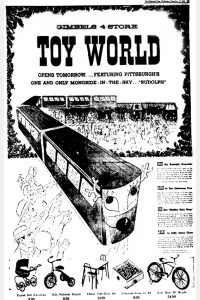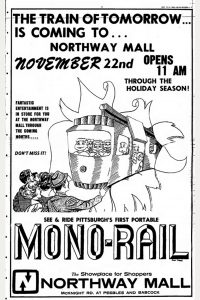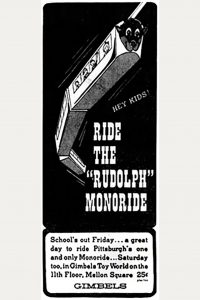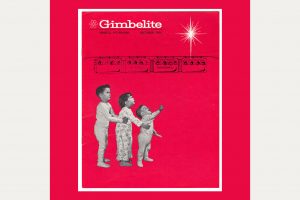Christmas train rides have long been cherished childhood holiday traditions. But during a few select years in the 1960s, Pittsburgh children could also ride a Christmas monorail.
The region was no stranger to futuristic transportation in this decade, as the centerpiece of the “Skybus” public transportation system was a vehicle commonly referred to as a monorail. But four months before the Skybus prototype began wowing locals in 1965 by circling Allegheny County’s South Park fairgrounds, a children’s monorail opened in Pittsburgh.
Peter Dibble, an Oregon-based graphic designer and documentary filmmaker interested in transportation history, debuted a now-viral YouTube video in December 2022 detailing these vehicles. Kid-sized aerial trains began appearing in 1946 in department stores and malls around the country, usually strategically placed over toy departments where they dazzled pint-sized riders with enticing views. The monorails operated seasonally and, in some places, throughout the year.
There were 26 children’s monorails scattered across the United States – including two in Pittsburgh.
From April 1965 until September 1967, the 11th Floor Toy World in Gimbels Mellon Square department store was home to “Pittsburgh’s first and only monoride.” The new elevated train consisted of three connected metal cars suspended from ceiling tracks to circle the toy department. Rides on the “streaking silver jet-age overhead train” could be taken on Saturdays through October for only 25 cents plus 2 cents tax.
Gimbels’ monorail debuted April 30, 1965, during the store’s annual “Lilac Time” spring anniversary sale. Opening day was marked by an appearance by Jane Vance Braham, host of WTAE-TV children’s television series Romper Room. “Miss Janey” was described in ads as a “guest stewardess” for the “Lilac Special.”
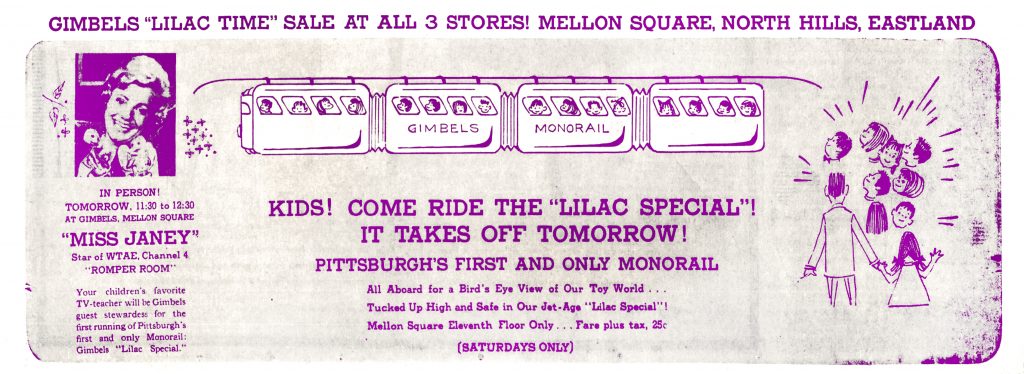
Image: The debut Gimbels’ monorail was advertised in the Pittsburgh Press, April 1965 (colorized).
In November 1965, the ride was rebranded as “Rudolph the Monoride.” The front car was graphically transformed into the flying reindeer who’d captured young imaginations a year earlier in December 1964, when the now-beloved stop-motion animated television special “Rudolph the Red-Nosed Reindeer” debuted.
Tom Fox and Charlie Brown were 18 years old when they were hired to run the Gimbels monorail along with other duties. Charlie noted that a station, complete with a ticket booth, stood near the 11th floor elevator bank. The ride was popular with children as young as two years. The young men wore red jackets and badges to signify their roles as conductors, and often had to lift children in and out of the train.
“The whole idea,” recalled Tom, “was for kids to see Santa and the toys. But some of them would be afraid and start crying halfway around.”
There was no way a distraught tot could be removed until the train returned to the station. Parents could reassure their nervous children by jogging along below, dodging displays while Christmas music piped through the store and the train rumbled above on its curved metal track, passing dangling decorations and Santa on his throne.
Despite this job on a futuristic transportation device, Tom had to hitchhike to work from his North Versailles home since area bus transportation was not reliable. His gig as a Gimbels monorail conductor helped pay for college, and perhaps hinted at his future career as Pennsylvania Turnpike Commission Public Information Manager. But it was his days as monorail operator that brought him youthful fame when children asked on the street, “Are you the monorail guy?”
Dave Hahner’s grandmother worked in Gimbels’ 13th Floor fur storage department, and five-year-old Dave rode the monorail as a special treat when meeting her after work during the holiday season. “I remember walking up a steep narrow ramp to the platform that was covered with a rubber no-skid surface, then sitting in the front seat looking down over the toy department during the ride.” The front car featured “Rudolph’s face with a bright red lightbulb for his nose. I believe the monorail train was white in color on the outside, or at least the front was white where Rudolph’s face was.”
A non-Rudolph monoride was advertised through September 1967. When the 11th Floor Toyland was remodeled for the 1967 holiday season Gimbels retired its monorail after only two years in service.
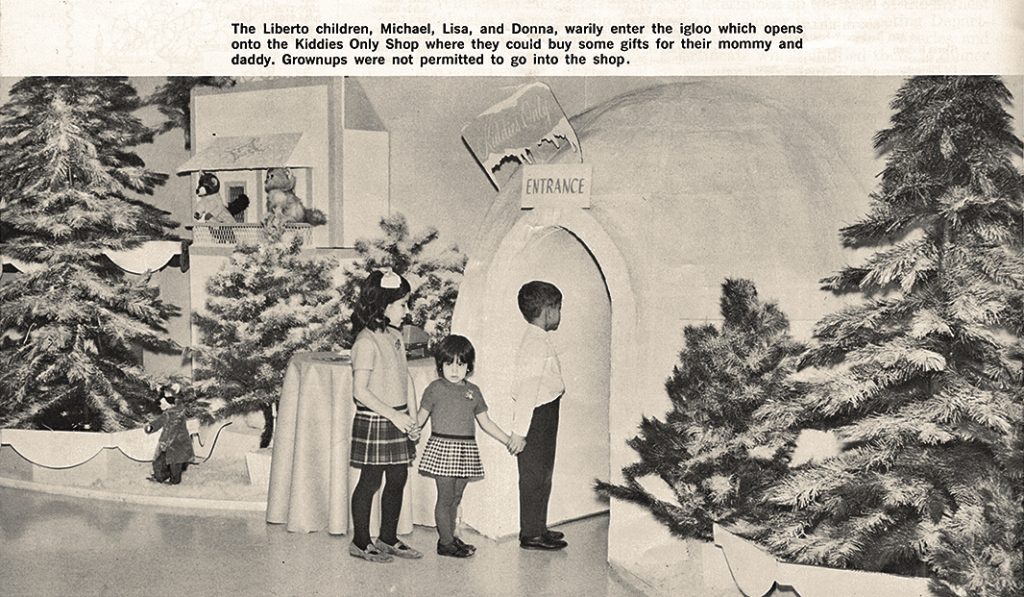
Image: Gimbels remodeled its Toyland in 1967, as seen in this Gimbelite employee magazine photograph. Detre Library & Archives, Heinz History Center.
In October 1968, management at Northway Mall on McKnight Road in Ross Township announced plans for its own holiday monorail. The ride would glide between the enclosed shopping center’s north and south courts. Local newspapers reported that it would hang 13 feet above ground on 400-450 feet of track. It consisted of “two-car trains, each 30 feet long,” that could each carry eight passengers.
Plans temporarily derailed when the monorail inexplicably disappeared after being shipped from Fairfield, Iowa. Newspapers across the country joked about the situation until the ride finally arrived a week late. A slightly delayed ribbon-cutting ceremony took place on Nov. 22, 1968, attended by Allegheny County’s Director of Port Authority, various officials, and county and township commissioners.
Former Pittsburgh resident Lucy Kusluch rode that Northway monorail years ago and said, “I remember it being small, or I was almost too big. Kind of claustrophobic to me, my sister wanted nothing to do with it! But I do remember going around the mall.”
As a seasonal installation, Northway’s monorail only lasted for a month. The Block Northway (as the complex is now called) has no archival photos of its brief run. Many holidays since then have included seasonal train rides at local malls, but those tracks were firmly laid on the ground.
Having read through the many comments on his viral Christmas monorail video, Peter Dibble reflected, “I’ve been surprised at just how many people around the country still remember these little rides after all these years. Some viewers have said that the video unlocked memories from their childhood that they had completely forgotten about. There’s something special about that, I think.”
Did you ride the holiday monorails at Gimbels or Northway Mall? We’d love to see your pictures! Check your photo albums and if you find anything, share them with [email protected].
About the Author
Regional public historian Sue Morris wrote about Pittsburgh’s Romper Room and early broadcast history in “Romper, Stomper, Bomper, Boo” for the Fall 2023 Western Pennsylvania History magazine. She explores Western Pa. history in her public lectures and blog, Historical Dilettante.

